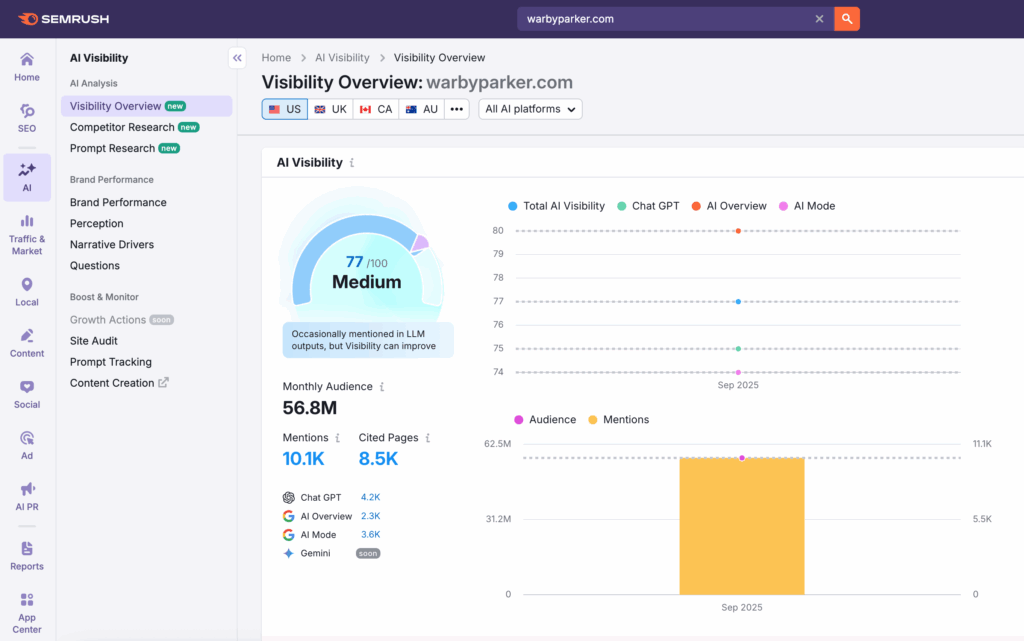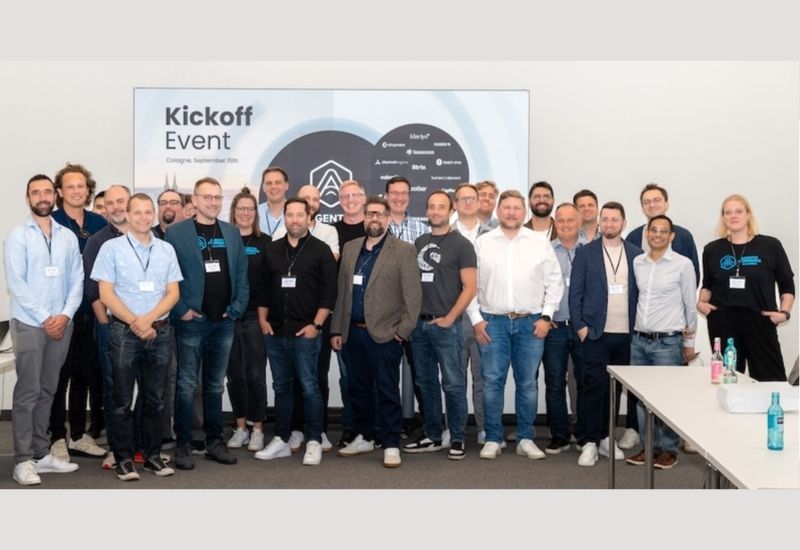“How do I optimize for AI search?” sounds like an innocent question — and yet! You’re asking the wrong question, and you might be setting yourself up to ruin your whole marketing strategy.
Let’s unpack that.
Why We’re Talking About “AI Search” in the First Place
Before we can talk about the rise of consumer AI, we need to talk about the biggest paradigm shift in the history of the internet: the decline of organic traffic. Since around 2022, clicks from organic search have been steadily dropping across every industry. That leaves people like me who have danced with Google professionally for the better part of a decade asking: “Well… what do I do now?”
So it makes sense that marketers would turn to “AI search” as the next big thing. If Google isn’t delivering clicks, maybe ChatGPT, Perplexity, or Gemini will. Right? Some other reasons focusing on AI search is hot right now are:
- Marketers’ historical reliance on keyword targeting — It’s been over a decade since we had decent keyword data in Google Analytics, and third-party tools have never reached the same level of data quality. Even so, picking target keywords and optimizing content is how it’s done for most SEOs.
- AI hype and platform ambitions — Everyone in the AI bubble wants “AI search” to take the place of traditional search, Google included. It’s an easy pitch to investors, it attracts headlines, and it makes sense on paper. In practice, though, effective use differs greatly between AI tools and the 10 blue links.
What’s different?
Why AI Search Isn’t “The Thing, Man”
It might seem like a small distinction, but thinking only in terms of “AI search” misses the forest for the trees when it comes to user behavior. These new platforms — like ChatGPT, Perplexity, Claude, and Gemini — encourage new interaction patterns and research methods. It’s not just a new place to find information, it’s new methods to find it.
1. New platforms, new behaviors
Google has one huge problem to solve before replacing the default search experience: money.
The “ten blue links” and their respective advertising placements made Google into an empire on the internet and without that, much of what we think of as “Google” would cease to exist: Docs, Drive, News, and even Chrome are all funded on the backs of ad dollars.
On the other hand, OpenAI is great at losing money. Ad revenue is still but a glimmer on the horizon for ChatGPT, so there’s nothing to lose by offering one result, maybe two, or no external links when responding to a question. Right now, user experience and user-guided behavior is the top priority in AI tools.
AI chats go so far beyond “conversational search.” Chats can continue with dozens, hundreds of messages, increasingly with language that will only make sense in the context of that conversation, and none of which resembles “auto parts retailer in Cleveland Ohio.” Remember when we all tried to optimize for voice search? That was a disaster because we were optimizing for a behavior that barely existed. The same trap lies in waiting for those who try to optimize for AI using traditional keyword research.
2. Chat interfaces just aren’t good at search
A couple weeks ago OpenAI released “ChatGPT Atlas,” their first attempt at an AI browser. It’s… fine. Pulling up an AI bot in a sidecar to ask questions about my open tabs is genuinely neat, and everything feels like Chrome for the most part. But part of the experience just feels off: searching.
My muscle memory is honed like a knife to Cmd+T, type out a Google search, and hit enter. I’ve done this dozens of times a day for almost two decades. But instead of my 10 blue links, my searches pull up the ChatGPT web search interface. After waiting 5-15 seconds for results, what I get back is a brief overview with scattered references, or sometimes genuine confusion from the chatbot. I tried finding where to order my favorite coffee table book, Microphones in 2020 (silent version), and instead of bringing me to the P.W. Elverum and Sun store, ChatGPT spat out this:

ChatGPT falls on its face with these searches. There’s a useless overview, a few links that are “right” but are devoid of descriptions and context, and I had to open a tab and TYPE “google.com” to get my day back on track.
Chat interfaces are designed for answering questions, not delivering search results.
3. But they are great for deeper engagement
When given the right prompt, AI tools excel where traditional search can’t: answering questions with citations and providing follow-up prompts. For marketers especially, the way that responses often close with additional offers of help like, “Would you like me to show you pictures of this?”, “What if I turned this information into a chart?”, “I can provide a list of instructional videos, just ask” prompt deeper engagement with nothing more than a “yes” response.
Question: How do you optimize for the keyword “yes”?
Answer: You can’t. But you can make the kind of content that is likely to be cited and surfaced for deep learning.
Thinking Beyond “Search”: Visibility in AI Tools
Instead of asking how to rank in AI results, ask how to show up in the kinds of conversations people are having inside these tools.

There are two broad visibility opportunities:
- Direct Research – Conversations where the AI is explicitly looking for products or services. (“Make me a list of auto parts retailers with parts for my car.”)
- Indirect Research – Conversations about related problems that cite or quote your content. (“How do I install this component?” — and the AI references your installation guide or parts catalog.)
Showing up for either of these opportunities requires the right type of content. AI tools favor depth and context. That means:
- Long–form blogs
- In-depth product or service pages
- Comprehensive guides and manuals
- PDFs, catalogs, and other structured content
These tend to surface more often than short, conversion-only landing pages or thin PDPs.
The Data Black Box Problem
Let’s talk about AI and site analytics. It’s a little ugly.
AI tools don’t care about your attribution models — and users care even less. In GA4, user journeys that start from (or are influenced by) AI tools might look like:
- Referral traffic from AI tool domains
- Referral traffic with a missing or random referrer
- Direct visits from copy-pasted links with or without UTM parameters (for no clear reason)
- Direct visits from typing out the damn URL of a cited resource (common with high brand familiarity)
- “Organic search” sessions that are actually follow-ups to AI chats
- “Organic search” sessions days, weeks, or months after a chat session
It’s messy, and it’s not getting cleaner anytime soon.
Measuring Success When AI Is a Key Channel
So how do you measure all this if attribution is broken?
- Track leads and revenue holistically. AI tools influence research behavior — often in a different session or device from the purchase. That means you’ll rarely see a clean attribution path.
- Ask your customers directly. For B2B, add questions about AI tools in your lead forms or discovery calls. For eCommerce, a simple checkout toggle like “Did you use AI tools to help you decide on this purchase?” can give you directional insight.
- Look at referral traffic carefully. If you’re seeing new “direct” or “unknown” referrers, that might actually be AI visibility at work. Even if users don’t click through every time, the brand exposure still counts.
The Bottom Line
Optimizing for “AI Search” is asking the wrong question for the medium. It presumes a one-step interaction using the kinds of search terms that work well on Google. Even if you optimize perfectly for AI search tools, they are only a tiny fraction of chat interactions.
Optimizing for AI visibility — being present, credible, and useful inside the conversations people are actually having — future-proofs your content and brand.
Search is changing, but curiosity isn’t. The brands that win next aren’t the ones who stuff the right keywords into their metadata — they’re the ones whose content deserves to be cited by the machines doing the talking.


